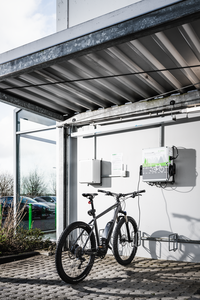The different variants of e-bike charging stations
There are currently a number of common variants for the charging of e-bikes. These may involve a locker system, a single station, or also a complete solution. The disadvantage for the user is that there is often only one socket at the charging point. With these solutions, it is necessary to carry your own charger.
For longer tours in particular, you should find out about the existing charging infrastructure beforehand. But who wants to look through all the different connector systems and variants? So, do I now have to pack my charger when I am leaving or not?

![[Translate to English - International:] Bosch Stecker E-Bike Ladestation](/media/redaktion/Loesungen/Elektromobilitaet/E-Bike_Ladestation/Funktion/Stecker-Bosch.png)
![[Translate to English - International:] Shimano Stecker E-Bike Ladestation](/media/redaktion/Loesungen/Elektromobilitaet/E-Bike_Ladestation/Funktion/Stecker-Shimano.png)
![[Translate to English - International:] Rosenberger Stecker E-Bike Ladestation](/media/redaktion/Loesungen/Elektromobilitaet/E-Bike_Ladestation/Funktion/Stecker-Rosenberger.png)
![[Translate to English - International:] XLR4 Stecker E-Bike Ladestation](/media/redaktion/Loesungen/Elektromobilitaet/E-Bike_Ladestation/Funktion/Stecker-XLR4.png)
![[Translate to English - International:] Yamaha Stecker E-Bike Ladestation](/media/redaktion/Loesungen/Elektromobilitaet/E-Bike_Ladestation/Funktion/Stecker-Yamaha.png)
![[Translate to English - International:] TG BCS 3 E-Bike Ladestation](/media/redaktion/Loesungen/Elektromobilitaet/E-Bike_Ladestation/Funktion/TGBCS3_Spelsberg.jpg)
![[Translate to English - International:] E-Bike Ladestation BCS Pure](/media/redaktion/Loesungen/Elektromobilitaet/E-Bike_Ladestation/Funktion/E-Bike-Ladestation_BCS.jpg)
![[Translate to English - International:] Schließfach E-Bike Ladestation](/media/redaktion/Loesungen/Elektromobilitaet/E-Bike_Ladestation/Funktion/Schliesssfach-E-Bike-Ladestation.jpg)